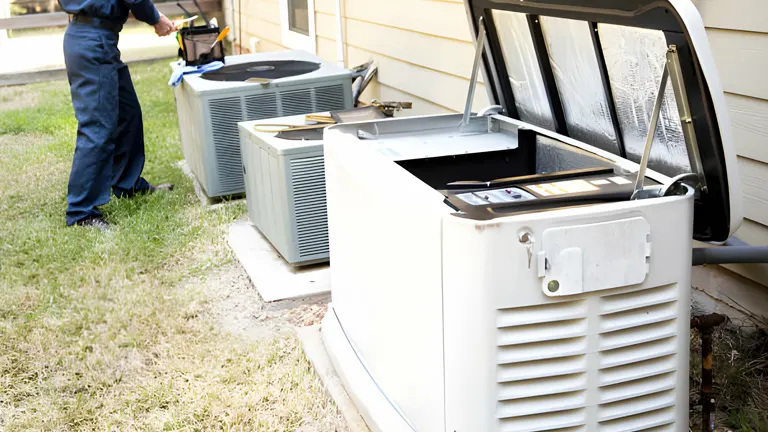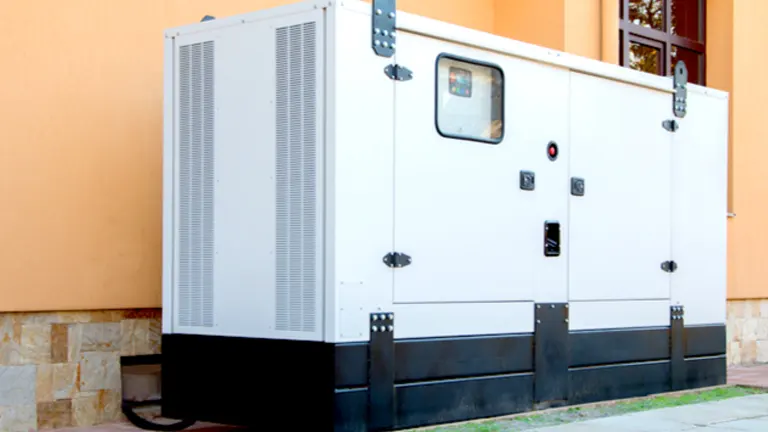What Size Generator to Run a House: Optimizing Home Energy
- January 29, 2024
- 0 comment
When power outages darken our doorstep, the inconvenience and discomfort can make any calm homeowner restless. Investing in a whole-home generator seems like a wise choice to keep the lights on and maintain normalcy.

But the crucial question remains: What size generator is necessary to power an entire house efficiently without overextending or underutilizing resources? This article dives deep into the process of determining the perfect generator size for your home, ensuring a balance between power availability and economical operation.
Understanding Generator Sizing
Generators are not sized by their physical dimensions but by their electrical output, measured in watts (W) or kilowatts (kW), with 1 kW equating to 1,000 W. The importance of choosing the right size cannot be overstated. A generator too small risks overloading and potential damage to both the generator and your appliances. Conversely, an oversized generator leads to unnecessary expenditure on both the unit and its operation.
Generator Size by Wattage and Power Category
| Watts (W) | Power Category | Tools/Appliances Included |
|---|---|---|
| 5,000W | Basic power system | Lights, fans, sump pump, refrigerator/freezer |
| 6,500W | Small power system | Lights, fan, sump pump, refrigerator/freezer, TV, entertainment system, heating/cooling system |
| 8,000W | Mid-sized power system | Above + Home office |
| 10,000W-12,000W | Emergency backup power system | Above + Kitchen (Total about 100 Amps) |
| 15,000W | Powerful system for a small home | Above + Laundry room (Total about 150 Amps) |
| 25,000W | Mini-power plant for a small to mid-sized home | Above + Air conditioning system (Total about 200 Amps) |
| 30,000W and up | Mini-power plant for a mid-sized to large home | All of the above and more. Live in total comfort. |
Generator Size Classification in kVA
| kVA | Suitable for |
|---|---|
| 10 kVA Generator | Multiple appliances and devices. Ideal for larger homes/businesses. |
| 3.5 kVA Generator | Essential appliances. Perfect for backup power during emergencies. |
| 20 kVA Generator | Robust power output. Great for comprehensive residential backup or smaller commercial applications. |
Calculating Your Home’s Generator Size in 3 Steps
- Begin by listing every appliance and fixture you wish to power.
- Note the starting (surge) wattage and running wattage for each item. Surge wattage is typically 2–3 times the running wattage, indicating the extra power required at startup. If these numbers are not readily available on the appliance, refer to a wattage estimation guide.
- Add together the wattage of all items to guide you in selecting the right size generator.
While a DIY wattage estimate is a good starting point, consulting a professional electrician or using a wattage calculator is recommended for a more accurate assessment.
Example: Powering the Essentials
Consider a scenario where you want to power essential appliances:
| Appliance | Starting Wattage | Running Wattage |
|---|---|---|
| Washing Machine | 1,200W | 1,200W |
| Clothes Dryer | 6,750W | 5,400W |
| Refrigerator/Freezer | 2,900W | 700W |
| 2-ton Central AC | 8,750W | 3,800W |
| Electric Water Heater | 4,500W | 4,500W |
The total starting wattage required is 24,100W, with a running wattage of 15,600W, indicating a minimum 25kW generator.
Example: Powering Your Whole Home
Expanding the list to include nearly everything in a home:
| Appliance | Starting Wattage | Running Wattage |
|---|---|---|
| Washing Machine | 1,200W | 1,200W |
| Clothes Dryer | 6,570W | 5,400W |
| Refrigerator/Freezer | 2,900W | 700W |
| 2-ton Central AC | 8,750W | 3,800W |
| Electric Water Heater | 4,500W | 4,500W |
| Electric Range | 2,100W | 2,100W |
| Microwave Oven (800W) | 1,300W | 1,300W |
| TVs (46″) | 380W | 380W |
| Security System | 550W | 550W |
| Laptop | 250W | 250W |
| Dishwasher (cool dry) | 540W | 216W |
| Light Fixtures (8+) | 1,100W | 1,100W |
| Garage Door Opener | 1,420W | 720W |
| Total | 31,560W | 22,216W |
Key Considerations in Generator Selection
- Include both starting and running wattage for each item.
- Use formulas for resistive (Watts = amps x volts) and reactive loads (Watts = amps x volts x load factor).
- Sum the power requirements of all intended appliances, adding the highest starting power for appliances with electric motors.
- Most generators should operate at a maximum of 80% of their capacity for longevity and safety.
- Consider the noise output of the generator, especially in residential areas or places with noise regulations.
- Local Regulations and Permits: Always check local regulations and obtain necessary permits before installing a generator to ensure compliance with zoning laws and safety standards.
- Protect your generator from the elements. Use covers or install it in an enclosure, especially in areas prone to extreme weather conditions.
- Store fuel for portable generators properly, adhering to local fire codes and ensuring containers are appropriate and placed in safe locations.
- Explore solar-powered or hybrid generators for an eco-friendly alternative that can reduce your carbon footprint.
- Weigh the initial costs against long-term benefits. Consider fuel consumption, maintenance expenses, and the potential increase in home value.
Generator Sizing Guide
Generators can range from 5,000W, providing basic power for essentials, to over 30,000W, serving as a mini-power plant for large homes or businesses. The size you choose should align with your specific power needs, avoiding the pitfalls of under or oversizing.
Navigating Portable and Standby Generators
Portable Generators

Ideal for emergency home use, typically starting at 5,000 watts. Quality is paramount for reliability and longevity. Safety tip: Never run portable generators indoors due to the risk of carbon monoxide poisoning.
Standby Generators

Provide seamless, automatic power to your entire home. These systems can be fueled by natural gas, propane, or diesel, and are suitable for critical applications, paired with a UPS for sensitive devices.
Selecting the right size generator is a balance between your power needs and cost-efficiency. Understanding your home’s power requirements and following the guidelines provided can lead to an informed decision, ensuring comfort, safety, and reliability when you most need it. Whether for basic needs or comprehensive home power, the right generator can be a beacon of light in the darkest of times.
Related Articles:
- Best Backup Generators 2024
- Best Home Generators
- Best Whole House Generators 2024
- Best Solar Generators of 2024: Proven Excellence for Off-Grid Living
FAQs
- Can I use a portable generator to power my entire home during an outage?
While portable generators can supply power to essential appliances, they may not have the capacity to power an entire home, especially if you have high-energy appliances. It’s important to calculate your total power needs and compare them with the generator’s capacity. - How do I ensure my generator doesn’t overload when multiple appliances start simultaneously?
To prevent overload, consider a generator with a built-in overload protection feature. Additionally, stagger the startup times of high-wattage appliances or invest in a generator with a higher capacity than your estimated need, adhering to the 80% rule. - Can I install a standby generator by myself, or do I need a professional?
It’s highly recommended to have your standby generator installed by a professional. Proper installation is crucial for safety, compliance with local codes, and ensuring that your warranty remains valid. - What’s the difference between running watts and starting watts, and why does it matter?
Running watts (or rated watts) are the continuous watts needed to keep appliances running. Starting watts (or surge watts) are the extra watts needed for two-to-three seconds to start motor-driven products. Knowing both is crucial for determining the total wattage required, so your generator doesn’t shut down or suffer damage. - How often should I perform maintenance on my home generator, and what does it entail?
Maintenance frequency varies by model and usage but generally includes checking the oil, air filter, and spark plugs, along with running the generator periodically to ensure it’s ready for use. Consult your generator’s manual for specific maintenance recommendations. - Are inverter generators worth the extra cost compared to standard portable generators?
Inverter generators are generally quieter, more fuel-efficient, and provide cleaner power (less electrical noise) than standard generators, making them ideal for sensitive electronics. The value for money depends on your specific needs, such as noise level tolerance, fuel efficiency, and the types of appliances you intend to power. - Do I need to consider the power factor when sizing a generator for my home?
Yes, especially if you’re powering items with electric motors or other inductive loads. The power factor represents the efficiency with which electrical power is converted into useful work output and should be factored into the calculation for accurate sizing. - Is it possible to connect renewable energy sources like solar panels to my backup generator system?
Some modern generators are designed to work in tandem with renewable energy sources. However, integrating them requires proper planning and equipment to ensure compatibility and safe operation. - How does altitude affect the performance of my generator, and should I consider this when choosing the size?
Generators can lose power output at higher altitudes due to thinner air, which affects engine and cooling performance. If you live at a high altitude, consider a generator with more capacity than your calculated need. - Can I run my generator in any weather condition?
Generators should be operated in well-ventilated, covered areas, protected from direct exposure to harsh weather conditions. While standby generators are typically built to withstand extreme weather, it’s essential to follow the manufacturer’s guidelines for operation and maintenance.
Join the conversation below by sharing your insights, experiences, or questions regarding home generators and energy optimization. Your input is invaluable, helping others navigate the complexities of selecting and maintaining the right generator for their needs. Together, let’s cultivate a community rich in shared knowledge, ensuring that every household makes informed decisions and remains powered, safe, and comfortable, even during unexpected outages. Share your story or tip today and empower fellow homeowners on their journey to energy independence!

David Murray
Forestry AuthorI'm David Murry, a forestry equipment specialist with a focus on chainsaw operation. With over 13 years of experience, I've honed my skills in operating and maintaining a wide range of machinery, from chainsaws to log splitters. My passion for the outdoors and commitment to sustainable forestry drive my work, which emphasizes safety, efficiency, and staying updated with industry advancements. Additionally, I'm dedicated to sharing my expertise and promoting environmental awareness within the forestry community.












Leave your comment